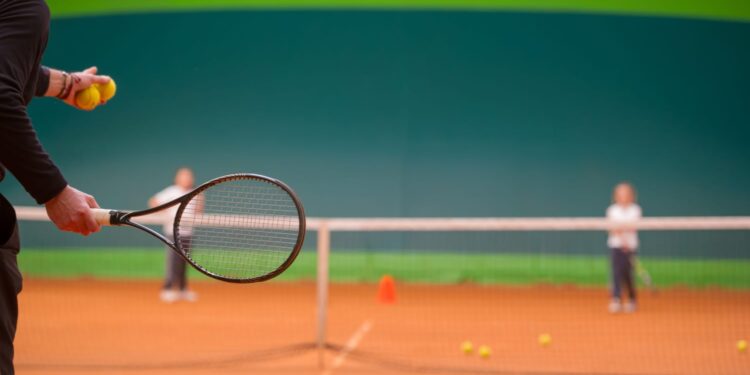Safety procedures to ensure physical distancing when teaching tennis.
Due to its natural ability to have players physical distance on opposite sides of the court, tennis is considered one of the safest sports to play during the pandemic. Players can meet on opposite ends of the court, without changing sides and leave the courts at different times to guarantee physical distancing.
However, some safety procedures may need to be implemented during a tennis class or clinic to guarantee physical distancing. During classes and clinics, tennis instructors can continue to provide a safe environment using several effective teaching methods and procedures from the field of applied behavior analysis.
Use of Stimulus Prompts. Setting up the court is an effective teaching procedure that provides players with quick and clear directions. The instructor will use chalk to draw shapes on the court for their players to use before and during class. This provides easy cueing while increasing physical distancing as the shapes on the court will prompt players to go to a specific area on the court.
For example, large circles drawn around the court provides a designated area players can put their items before class such as racket bags, masks, and water bottles while staying physically distant from other players and the instructor. An “X” on the court could direct players to prepare for groundstrokes drills, while an “O” on the court could symbolize volley drills. Providing stimulus prompts is an antecedent strategy, which can increase the likelihood that players will remain physically distant throughout the activity.
Prompts and Models from the Instructor. The instructor can provide appropriate modeling for players to increase physical distancing during class. For example, the instructor can demonstrate how to move away from another person properly when they come in proximity. The instructor can also provide modeling of verbal prompts for physical distancing through words and phrases.
Additionally, the instructor should also model other replacement behaviors such as players who have an itchy nose or sweat on their face to increase healthy hygiene behaviors. They can model how to use their elbow or their shirt to scratch their nose or wipe sweat off their face. When players demonstrate using their elbow or their shirt, the instructor should provide descriptive praise.
Prompts and Modeling from Other Players. Encourage the players to help assist other players by teaching them to model physical distancing behaviors. Teaching players to put their hand out in front of their body as a physical gesture is a prompt to ensure players stop and maintain distance from others.
Size of Classes. Smaller class sizes, such as four to six participants, allow more individualized attention, verbal instruction and praise. In observations, smaller class sizes increased participants likelihood of practicing physical distancing.
Instructor Antecedent Manipulation. Activity selection is a vital component to ensure players are practicing safe distancing. The instructor is responsible for providing activities that will increase distancing behaviors. For example, at the beginning of class, the instructor can instruct players to walk on to the court with their mask and stand on their circle that will be their space for the entire class. Everyone can have their own sanitized tube for tennis ball collection. Once all the players are in their circle, they would be permitted to take off their masks. The players will be instructed one at a time to go to the X on the court deemed by the instructor. Once each player is standing on an X, the instructor will then explain the activity. It is critical for the instructor to explain and model the tennis shot the players will be hitting, how many times the player will hit the ball, and what direction the player will go after their turn is complete, while making sure each player remains physically distant.
Instructors can also increase healthy hygiene behaviors by setting up the environment with “healthy hygiene stations” as a visual prompt for players. These stations include access to tissue boxes, trashcans and hand sanitizer stations. These stations are located in corners of the court for participants to access quickly and independently. Additional strategies include providing positive praise for players who practice using the “station” as a replacement behavior to using their hands in order to increase the likelihood that participants will use the “station” to practice healthy hygiene behaviors in the future.
Dress Code. It is recommended instructors require players to have their hair pulled from their face before starting class to increase the likelihood that players will keep their hands away from their face. In observations, players who had their hair down or falling out of their ponytail and clip, there was a higher chance the player would use their hands to touch their face.
Competing Physical Behaviors. A behavior that is incompatible with face touching is players holding rackets in their hands. Players who keep busy such as participating in hitting groundstrokes, are less likely to touch their face.
When an instructor uses visual prompts, verbal instructions, positive praise and reinforcement, there is a high probability players will increase their physical distancing and healthy hygiene behaviors. Therefore, using effective methods and procedures during classes and clinics can increase safety in small group settings, such as teaching tennis.










